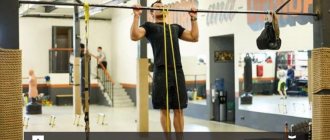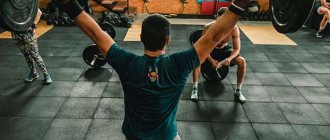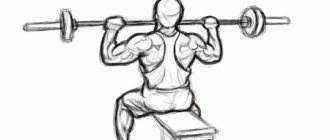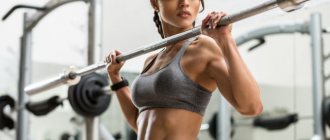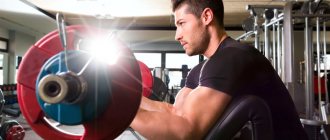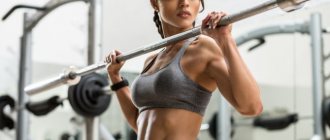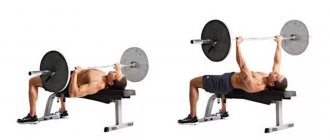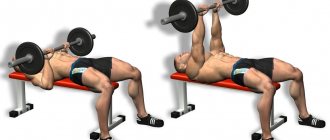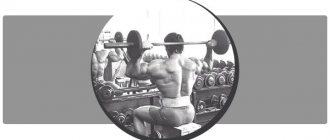Attention: if you are performing the bench press for the first time, you will need a backup. If there is no one to back you up, use light weights or a Smith machine.
Try not to lean the projectile forward and lower it clearly to the center of your chest.
Don't bounce the barbell away from your pectoral muscles! Control your technique throughout the entire movement.
Execution options
The bench press with a barbell is performed both on a horizontal bench and on a bench with a positive or negative incline.
In the first case, when the back is raised up, the muscles of the upper chest work to a greater extent. If the backrest is lowered, the emphasis shifts to its lower part.
Grip width
Grip width is also important in this exercise. It can be medium, as described in the article, narrow or wide:
- When using a narrow grip, the triceps and inner chest are more loaded
- With average - middle part
- With a wide grip, the load falls on the outer bundles of the pectoral muscles
What muscles work in the exercise
The bench press is a key exercise for stimulating muscle growth and strength throughout the upper body.
Its high efficiency is explained by the large number of muscle groups involved in the movement:
- The main moving muscles are the chest, shoulders (anterior deltoid) and triceps
- Auxiliary – lats, forearms and small stabilizer muscles that help maintain balance when lifting the barbell
And this is only the muscle involvement during the bodybuilding bench press technique.
In powerlifting, the exercise is performed using the strength of the muscles of the entire body. In addition to those listed above, the work also involves the thighs, calves, gluteals, lumbar and even biceps.
Anatomy of the bench press
When people talk about the bench press, they assume that it trains the pectoral muscles, although quite often this is not the case. When performing the bench press, the pectoral muscles, anterior deltoids and triceps are loaded. Unfortunately, it is impossible to direct the load only to the pecs; deltoids and triceps will always work as synergists. When performing the bench press correctly (for bodybuilding), about 60-70% of the weight load should fall on the pectoral muscles, and the rest on the deltoids and triceps.
Features of the exercise and its benefits
As you probably already know, there are two main and fundamentally different techniques for performing the bench press. Let's look at each in more detail.
Bench press in bodybuilding
Here the exercise is used to stimulate muscle growth in the pectoral muscles. This involves a certain technique.
The main goal of the bodybuilding press is to exclude auxiliary muscles from the work, so that the maximum load falls on the chest.
The press technique has the following nuances:
- The press is done with a “flat” back and without strong emphasis on the legs
Flat, which means with minimal deflection in the lumbar region. There is even a bench press option with your legs in the air to eliminate the help of your legs in lifting the barbell.
- Elbows spread to the sides (cross press)
This position ensures maximum activation of the pectoral muscles. True, there is also a negative point. When doing a cross press, the pectoral ligaments and shoulder joints are overloaded.
It is anatomically inconvenient for the pectoral ligaments to work at this angle.
Gradually, this leads to the fact that when training with heavy weights, the load on the ligaments increases, increasing the risk of injury.
Among professional bodybuilders, torn pectoral muscles and ligaments are the same norm as bench pressing 200 kg.
Raising your elbows to the sides also overloads the fragile shoulder joint.
- Often, in order to ensure constant tension in the pectoral muscles, the movement is performed in an incomplete amplitude
To do this, at the top point the arms are not specifically straightened to the end, and in the lower phase of the movement the bar may not even touch the chest.
Bench press in powerlifting
The goal of the barbell press in powerlifting is to lift the heaviest weight possible for one repetition. Muscles are not a priority here.
For this purpose, the manner of execution differs from that of a bodybuilder. And here the answer to the question of how to do a barbell bench press correctly sounds different:
- In the initial position, a “thoracic bridge” is performed, with maximum deflection in the lumbar region. Firm foot rest on the floor is required
This starting position helps to include large muscle groups in the movement - legs, back, chest, shoulders and arms. As a result, the press is performed with the whole body, but the load on the pectoral muscles is reduced.
- The grip width in the bench press is regulated by the competition rules and is no more than 81 cm
The position of the elbows depends on individual technique. But most often, the elbows are brought forward and slightly pressed towards the body.
This trick helps you make the most of your shoulder and triceps strength.
- Using other “tricks” to make movement easier
For example, bringing your shoulder blades together at the start or lowering the barbell into the solar plexus area.
All this is subordinated to one goal - to squeeze the barbell with more weight. They don’t think about any pumping of the pectoral muscles here. If you need to increase their mass, other exercises are used in powerlifting.
How often to do the bench press
Different training systems recommend different frequencies. From three times a week to 1 time every 10-12 days.
The more weight you lift, the more days you have to rest gently after bench pressing.
The author of this article considers this schedule optimal. Do bench presses 2-3 times a week. But be sure to use the principle of load periodization. There should only be one really hard bench press workout per week. And the other 1-2 workouts should help maintain and develop the exercise technique. Such workouts are performed with medium and light weights with an increased number of repetitions.
For example:
Monday
Bench press: 5x5 (85% of maximum)
Thursday
Bench press: 4x12 (65% of maximum)
Bench Press Recommendations for Men
The bench press is used by both men and women, differing in some features.
Men use in their training both the bodybuilding style when training for muscle mass or relief, and the powerlifting style. For example, during the period of strength work.
When using the bench press to increase muscle mass, remember that the horizontal bench press is more conducive to hypertrophy of the middle and lower chest.
If you perform only this method of bench press for a long time, over time a disproportion in the structure of the chest develops - a pumped bottom and a hollow in the upper part. As a result, the effect of sagging breasts appears.
To prevent this from happening, pay close attention to your upper chest from your first workouts. By performing exercises on an incline bench with your head up, you will create a proportional and symmetrical shape.
Bench press only with a wide grip loads mainly the outer part of the chest, weakly developing the inner one.
To avoid this imbalance, regularly change your grip width from workout to workout. In this case, the pectoral muscles will look harmonious.
Grips for pull-ups on the horizontal bar.
This is where all sorts of different grips are used, namely when doing pull-ups on the horizontal bar. What you get as a result depends on exactly how you grab the crossbar. Different grips will help athletes with different levels of training achieve the desired result.
Using a reverse grip helps beginners master pull-ups, as it makes it easier to perform the exercise due to the fact that stronger biceps are involved in the work and removes some of the load from the back. The width of the grip helps the experienced athlete concentrate the load on individual areas of the back and work the target muscles.
As you can see, different grip styles are an important part of the training process, so it is advisable to take the time to learn how to use them in different situations. Knowing the intricacies and characteristics of different types of grip and applying them in practice will help diversify and improve your training, which in turn will help you achieve the result you want.
Bench press recommendations for girls
As for women, they do not have a particular need to perform a power bench press. Except when they specifically do powerlifting.
The classic version of the bench press is more suitable for girls. But there is one nuance here too.
The structure of the breasts in women is different from the anatomy of men. In women, 70% of the breast consists of adipose tissue and mammary gland. As for the chest muscles, they are located under this same fatty tissue and are practically invisible visually. Only in the upper, supraclavicular part, part of the pectoral muscles is noticeable in girls.
These anatomical features also influence the choice of exercises.
If girls are working out for muscle tone or to lose weight, then there is no point in doing a horizontal barbell bench press. After all, here the load goes on the middle and lower parts of the pectoral muscles, which are not visible in women.
In this case, the horizontal press is more suitable for developing the shoulders and triceps, which is also good.
If it is the pecs that you need to develop, it is better to choose a barbell or dumbbell bench press while lying on an incline bench.
The exercise is more suitable for women, because it promotes the development of the upper chest. The same one that girls see.
Crazy legs
If you're going to be lifting heavy weights, start by establishing a secure base and using your entire body correctly. I meet guys all the time who, in a desperate attempt to squeeze out “just one more time,” kick the air with their feet as if they are trying to strangle them. It’s even worse when the athlete puts both legs on the bench - this position does not provide any advantages, and it is useful only for those who are practicing rope walking skills.
How will be correct? We take our starting position on the bench and pull our legs towards the head until the moment when the heels lift off the surface a little more. At this point, we fix the feet and make sure that the heels touch the floor throughout the entire approach.
To lift heavy weights, start by establishing a secure base and using your entire body correctly.
By the way, if you have long legs, the prerequisites are created for the pelvis to lift off the bench; To avoid this, simply spread your legs wider. In the initial phase of the exercise, “drill” your heels into the floor - they should remain in this position until you complete the approach.
Using an exercise in a training program
As a rule, the bench press is always number one in chest training. Moreover, regardless of the period of training, be it mass, strength or relief. This applies more to beginners and intermediate levels.
Advanced athletes are no longer concerned with gaining total muscle mass in the chest, but with bringing it to the desired proportions. At this level of training, much less emphasis is placed on the flat bench press.
Usually it is replaced with a dumbbell press, as this exercise contributes to more harmonious development of the chest.
The emphasis of the load shifts to the upper part of the pectoral muscles, and most exercises are performed while lying on an inclined bench.
Open grip
Open grip - thumb under the bar
The most unfortunate and unsafe option. In this version, the bar essentially just lies in the palm of your hand, not fixed in any way.
As an argument in favor of this type, you can hear: “I feel the chest muscles better this way.” Moreover, the relationship between the hand and the muscles of the chest and hand is, as a rule, not specified. The competitive bench press is an exercise where the “feeling” of the muscles can be neglected. But safety precautions in this case are a priority. There have been repeated cases where the barbell fell out of the hands of athletes during a dynamic bench press. If at that moment there were no safety stops installed on the bench (and, as a rule, not everyone wants to bother with adjusting them), then the barbell with the working weight fell straight on the athlete (on the face with or without glasses, on the neck, on the chest) .
The argument “it’s so convenient for me” is also easily shattered: when setting up equipment or its elements, some “inconvenience” is the norm. It is impossible to improve your skill in a single movement without overcoming some amount of discomfort. But, having overcome it, there is every chance to really improve the result without the risk of getting damaged.
It should be noted that this type of grip is prohibited in powerlifting and bench press competitions in all federations due to its risk of injury, and for good reason.
Thick neck[edit | edit code]
In addition to the regular neck, there is also a thicker version. True, none of our editorial staff ever managed to meet it in their lives, therefore, when working with a thickened bar (and it is needed not only in bodybuilding, but also in arm wrestling), we had to design it ourselves. Which, in general, is not so difficult. Option one is an ordinary towel, which should be wrapped tightly enough around the bar. Option two is to use foam pads, which, as a rule, lie idle in every gym and are occasionally used when doing squats. In any case, the thickness of the neck should be such that the index and thumb do not close together (there should be about a centimeter between them).
Shrugging
When you lie on a bench, your shoulders should not rise above your ears. In this tight position, you won't be able to use your pecs to their full potential and will completely exclude your lats from the exercise - yes, your lats also contribute to the bench press.
Instead of shrugging, engage your lats and pull your shoulders down toward your pelvis, squeezing your shoulder blades together. This movement will create an arch in the back, but the gluteal region will be fixed, and only the upper part of the body will form a kind of bridge. And one more thing - always look straight ahead and do not press your head to the bench. The latter is fraught with injuries to the cervical spine.
Engage your lats and pull your shoulders down toward your pelvis, squeezing your shoulder blades together
Asymmetrical grip[edit | edit code]
When you work with dumbbells, you usually grab them by the handle exactly in the middle. The only exception is the “hammer” style curl - here you move the grip to the outer edge of the dumbbell, although in this case it will not be outer: since our grip is neutral, the hand is located closer to the edge pointing upward) . Now try to grab the dumbbell in the same way - as close to the outer edge as possible - but maintain a supinated grip (fingers pointing up - see photo) throughout the entire range of motion. Unforgettable sensations in the biceps are guaranteed!
Chest trampoline
Fortunately, I see this violation much less often today than in the old days, but back in the day, guys would toss the barbell with their chests like a soccer ball. This is another form of fraud that is counterproductive and, you better take my word for it, very, very dangerous.
I knew a guy who never bench pressed a barbell without bouncing off his chest. Later, he found himself competing for the first time and was forced to take a short break at the bottom. His pectoral muscles ended up ripping apart like an old, worn-out towel.
The downward phase should be smooth and controlled, as if you were squeezing a heavy spring.
Not long ago, an “updated” version of the chest trampoline appeared: guys drop the barbell, and then frantically catch the bar a couple of centimeters above the chest. But what does this give them? By shortening the negative phase of the press, they are deceiving themselves, since in terms of its anabolic effect this part of the exercise is in no way inferior to the positive phase.
Imagine this analogy: the downward phase should be smooth and controlled, as if you were compressing a heavy spring. When the bar touches your chest, the spring begins to straighten, helping you overcome your sticking point.
